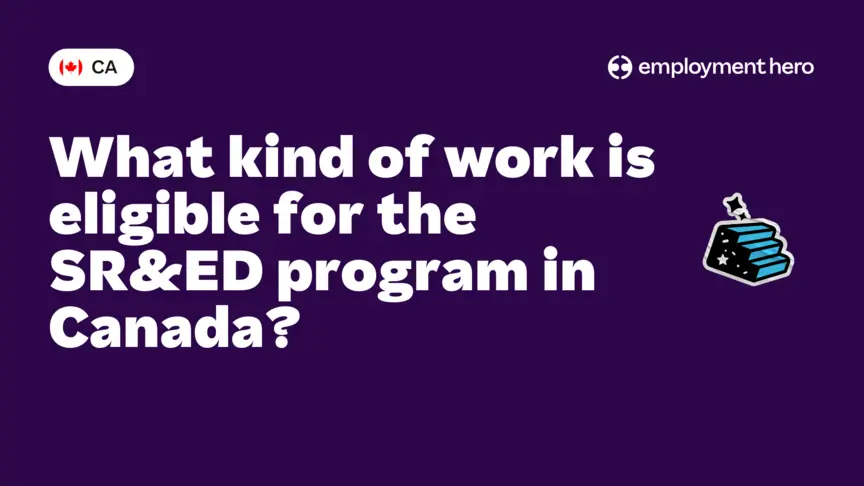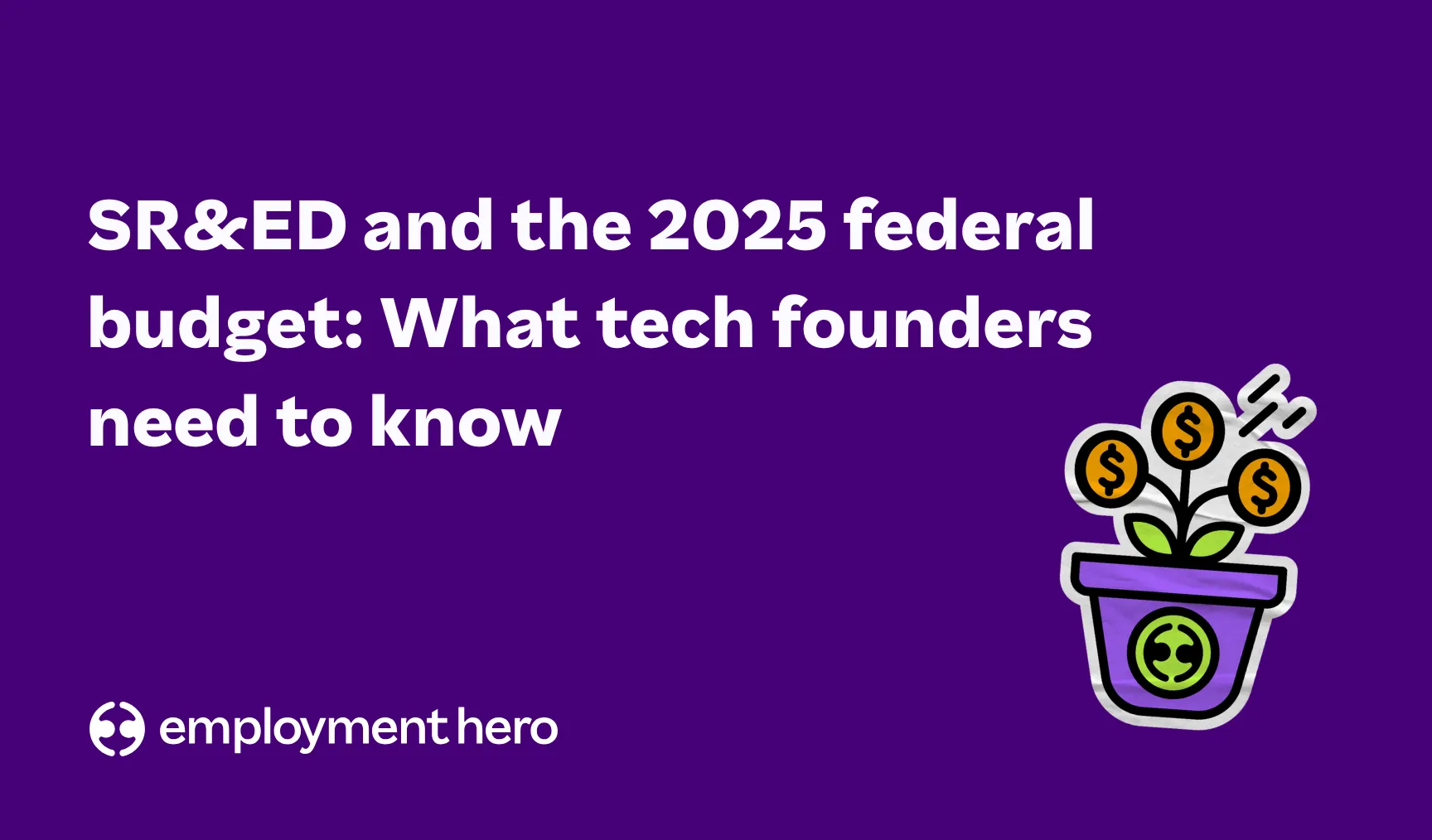What kind of work is eligible for the SR&ED program in Canada?
Learn all about what kind of work is eligible and the criteria to determine if your organization can receive financial support through SR&ED.

Contents
From startups developing new solutions to established companies innovating on existing methods, many Canadian businesses engage in innovative activities to advance their products, processes, or technologies. And while the constant push for progress is great, it can prove costly.
The good news? The Canadian government recognizes this and created the Scientific Research and Experimental Development (SR&ED) program to offer tax incentives that lighten the financial load of innovation.
In this blog post, we’ll get into what kind of work is eligible and the criteria you need to meet to help you determine if your organization can receive financial support through SR&ED.
Let’s dive in!
The two-part framework to determine SR&ED eligibility
To tap into the SR&ED program, your work must meet two critical criteria that have to do with the why and how of your work. The Canada Revenue Agency (CRA) now uses a simplified, two-part framework to determine eligibility.
- The ‘Why’: Advancement of Scientific or Technological Knowledge.
The core purpose of your work must be to achieve a scientific or technological advancement. This means generating new knowledge or understanding that goes beyond what is currently known in your field. This advancement must be aimed at resolving a scientific or technological uncertainty—a situation where you can’t determine if a goal can be achieved or how to achieve it based on existing knowledge. The SR&ED program is for projects that genuinely push boundaries, not for those that apply existing knowledge in a routine way.
- The ‘How’: Systematic Investigation.
The work must involve a systematic investigation or search, carried out through experiment or analysis. This means you can’t just stumble upon a solution. Your project needs to follow a structured, planned approach to tackle the scientific or technological uncertainty.
This systematic process includes:
- Formulating an idea or hypothesis to resolve the uncertainty.
- Testing this hypothesis through experiments or analysis.
- Drawing logical conclusions based on the results.
- Keeping clear records of the work, including hypotheses, experiments, results, and conclusions.
The CRA expects you to have a documented record of your project’s progress. This evidence is crucial for demonstrating that your work wasn’t just random trial and error, but a rigorous, scientific approach to innovation.
What counts as SR&ED work?
SR&ED work falls into several categories, each with its own set of guidelines:
Basic research
This is research purely aimed at advancing scientific knowledge without a specific practical application in mind. For example, researching a new virus to better understand it. This high-level research is mostly done in universities and leading research institutions, with findings typically shared through scientific journals.
Applied research
This would be targeted research with a specific practical application in view. For example, research towards developing a vaccine for a new virus.
Experimental development
This work is aimed at achieving technological advancements for creating new, or improving existing, materials, devices, products, or processes. For example, finding ways to scale up and optimize the production of a new vaccine.
Support work
Support work that directly contributes to the research activities above can also qualify, including engineering, design, operations research, mathematical analysis, computer programming, data collection, testing and psychological research.
Taking the example of a new vaccine, if you were performing tests on a new process used to scale production, this would be considered support work for your experimental development.
What doesn’t qualify under the SR&ED program?
This work falls outside the scope of SR&ED and does not qualify for consideration or claims:
- Market research or sales promotion
- Quality control or routine testing of materials, devices, products, or processes
- Research in the social sciences or the humanities
- Prospecting, exploring or drilling for, or producing, minerals, petroleum or natural gas
- The commercial production of a new or improved material, device, or product or the commercial use of a new or improved process
- Style changes
- Routine data collection
Navigating SR&ED
Understanding the SR&ED program’s intricacies might be daunting, but the potential rewards for your business are worth the effort. You could be looking at a significant tax credit that’ll fuel further innovation and growth – so you can keep the good ideas coming!
Whether you’re in the early stages of exploring a groundbreaking idea or looking to refine an existing product or process, the SR&ED program offers a pathway to bring your visions to life, all while boosting Canada’s position on the global stage of innovation.
Recent changes made to the SR&ED program
While the core principles of SR&ED remain the same, the program has several proposed reforms in the 2024 Fall Economic Statement. These proposed SR&ED reforms are meant to be in effect for taxation years that begin on or after December 16, 2024:
- Restoration of capital expenditures: For the first time since 2014, the government has proposed that capital expenditures be eligible again under the SR&ED program. This would mean that the costs of equipment, machinery, and other depreciable property used directly for R&D work could be claimed for tax credits and deductions. This proposed change would apply to property acquired on or after December 16, 2024.
- Increased expenditure limit for enhanced credits: It has been proposed that the annual expenditure limit for Canadian-Controlled Private Corporations (CCPCs) to claim the enhanced 35% tax credit be raised from $3 million to $4.5 million. This would allow qualifying companies to receive more financial support for their R&D activities.
- Extending eligibility for public corporations: A major proposal is to extend the enhanced 35% refundable tax credit, which was historically reserved for CCPCs, to include eligible Canadian public corporations. This would provide larger companies with a new source of cash flow to fuel their research and development efforts.
- Higher phase-out thresholds: The taxable capital phase-out thresholds for the enhanced credit have been raised from $10 million and $50 million to $15 million and $75 million, respectively. These new thresholds apply to taxation years that begin on or after December 16, 2024.
Wrapping up
By familiarizing yourself with the eligibility criteria and application process of the SR&ED program, you can determine if your work qualifies.
This program can be a real game-changer, fuelling even more creative problem-solving and propelling your work toward success. Remember, innovation keeps Canada moving forward, and the SR&ED program is here to help businesses like yours thrive!
Related Resources
-
 Read more: Payroll insights and HR lessons from 2025: Your 2026 guide
Read more: Payroll insights and HR lessons from 2025: Your 2026 guidePayroll insights and HR lessons from 2025: Your 2026 guide
Discover key HR and payroll insights from 2025 to guide your 2026 strategy. Learn about compliance updates, trends and best…
-
 Read more: 2025 federal budget: What Canadian employers need to know
Read more: 2025 federal budget: What Canadian employers need to know2025 federal budget: What Canadian employers need to know
Discover what Canada’s 2025 federal budget means for employers, from enhanced SR&ED incentives to new talent and funding opportunities.
-
 Read more: What tech founders should know about the 2025 federal budget and why this year is the perfect time to double down on SR&ED
Read more: What tech founders should know about the 2025 federal budget and why this year is the perfect time to double down on SR&EDWhat tech founders should know about the 2025 federal budget and why this year is the perfect time to double down on SR&ED
Discover how the 2025 federal budget enhances SR&ED for Canadian startups. Learn how founders can maximize refunds, extend runway and…


















